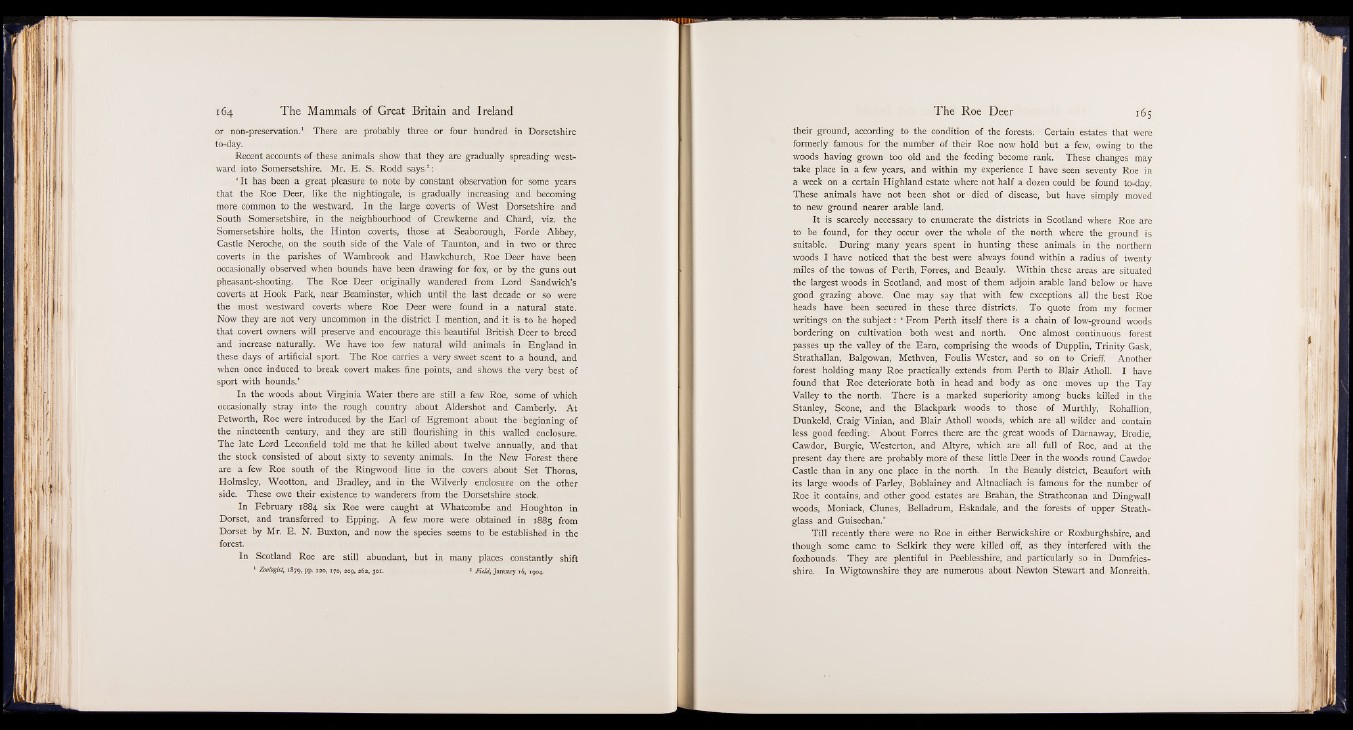
or non-preservation.1 There are probably three or four hundred in Dorsetshire
to-day.
Recent accounts of these animals show that they are gradually spreading westward
into Somersetshire. Mr. E. S. Rodd says2:
‘ It has been a great pleasure to note by constant observation for some years
that the Roe Deer, like the nightingale, is gradually increasing and becoming
more common to the westward. In the large coverts of West Dorsetshire and
South Somersetshire, in the neighbourhood of Crewkerne and Chard, viz. the
Somersetshire holts, the Hinton coverts, those at Seaborough, Forde Abbey,
Castle Neroche, on the south side of the Vale of Taunton, and in two or three
coverts in the parishes of Wambrook and Hawkchurch, Roe Deer have been
occasionally observed when hounds have been drawing for fox, or by the guns out
pheasant-shooting. The Roe Deer originally wandered from Lord Sandwich’s
coverts at Hook Park, near Beaminster, which until the last decade or so were
the most westward coverts where Roe Deer were found in a natural state.
Now they are not very uncommon in the district I mention, and it is to be hoped
that covert owners will preserve and encourage this beautiful British Deer to breed
and increase naturally. We have too few natural wild animals in England in
these days of artificial sport. The Roe carries a very sweet scent to a hound, and
when once induced to break covert makes fine points, and shows the very best of
sport with hounds.’
In the woods about Virginia Water there are still a few Roe, some of which
occasionally stray into the rough country about Aldershot and Camberly. At
Petworth, Roe were introduced by the Earl of Egremont about the beginning of
the nineteenth century, and they are still flourishing in this walled enclosure.
The late Lord Leconfield told me that he killed about twelve annually, and that
the stock consisted of about sixty to seventy animals. In the New Forest there
are a few Roe south of the Ringwood line in the covers about Set Thorns,
Holmsley, Wootton, and Bradley, and in the Wilverly enclosure on the other
side. These owe their existence to wanderers from the Dorsetshire stock.
In February 1884 six Roe were caught at Whatcombe and Houghton in
Dorset, and transferred to Epping. A few more were obtained in 1885 from
Dorset by Mr. E. N. Buxton, and now the species seems to be established in the
forest.
In Scotland Roe are still abundant, but in many places constantly shift
1 Zoologist,\ 1879, pp. 120, 170, 209, 262, 301. 8 Field, January r6, 1904.
their ground, according to the condition of the forests. Certain estates that were
formerly famous for the number of their Roe now hold but a few, owing to the
woods having grown too old and the feeding become rank. These changes may
take place in a few years, and within my experience I have seen seventy Roe in
a week on a certain Highland estate where not half a dozen could be found to-day.
These animals have not been shot or died of disease, but have simply moved
to new ground nearer arable land.
It is scarcely necessary to enumerate the districts in Scotland where Roe are
to be found, for they occur over the whole of the north where the ground is
suitable. During many years spent in hunting these animals in the northern
woods I have noticed that the best were always found within a radius of twenty
miles of the towns of Perth, Forres, and Beauly. Within these areas are situated
the largest woods in Scotland, and most of them adjoin arable land below or have
good grazing above. One may say that with few exceptions all the best Roe
heads have been secured in these three districts. To quote from my former
writings on the subject: 1 From Perth itself there is a chain of low-ground woods
bordering on cultivation both west and north. One almost continuous forest
passes up the valley of the Earn, comprising the woods of Dupplin, Trinity Gask,
Strathallan, Balgowan, Methven, Foulis Wester, and so on to Crieff. Another
forest holding many Roe practically extends from Perth to Blair Atholl. I have
found that Roe deteriorate both in head and body as one moves up the Tay
Valley to the north. There is a marked superiority among bucks killed in the
Stanley, Scone, and the Blackpark woods to those of Murthly, Rohallion,
Dunkeld, Craig Vinian, and Blair Atholl woods, which are all wilder and contain
less good feeding. About Forres there are the great woods of Darnaway, Brodie,
Cawdor, Burgie, Westerton, and Altyre, which are all full of Roe, and at the
present day there are probably more of these little Deer in the woods round Cawdor
Castle than in any one place in the north. In the Beauly district, Beaufort with
its large woods of Farley, Boblainey and Altnacliach is famous for the number of
Roe it contains, and other good estates are Brahan, the Strathconan and Dingwall
woods, Moniack, Clunes, Belladrum, Eskadale, and the forests of upper Strath-
glass and Guisechan.’
Till recently there were no Roe in either Berwickshire or Roxburghshire, and
though some came to Selkirk they were killed off, as they interfered with the
foxhounds. They are plentiful in Peeblesshire, and particularly so in Dumfriesshire.
In Wigtownshire they are numerous about Newton Stewart and Monreith.